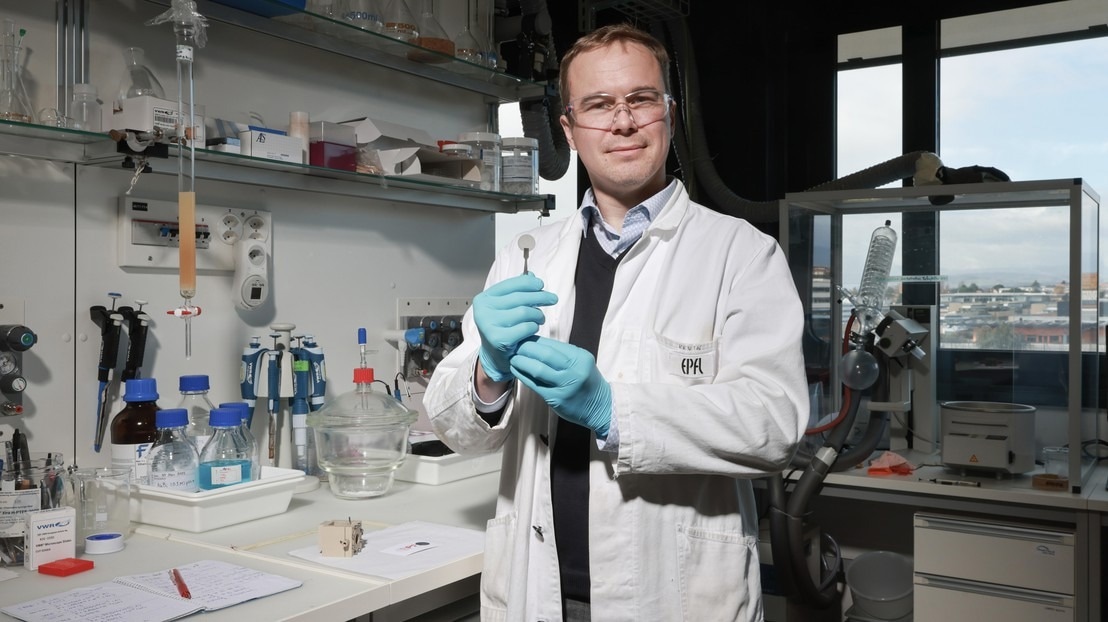Reviewed by Alex SmithJan 5 2023
Chemical engineers from EPFL (École polytechnique fédérale de Lausanne) have created a solar-powered artificial leaf on the basis of a porous, transparent novel electrode. The technology exhibits the potential to harvest water from the air to transform into hydrogen fuel.
 Kevin Sivula and his team invented a solar-powered artificial leaf for harvesting hydrogen fuel from humid air. Image Credit: 2023 EPFL / Alain Herzog
Kevin Sivula and his team invented a solar-powered artificial leaf for harvesting hydrogen fuel from humid air. Image Credit: 2023 EPFL / Alain Herzog
The semiconductor-based technology is scalable and simple to create. A device that has the potential to harvest water from the air and offer hydrogen fuel—completely powered by solar energy—has been a big goal for scientists for several years.
At present, EPFL chemical engineer Kevin Sivula and his team have made a considerable step towards making this vision closer to reality.
The researchers have come up with a clever yet easy system that integrates semiconductor-based technology along with novel electrodes that have two main characteristics: they are porous to optimize contact with water present in the air, and transparent to optimize sunlight exposure of the semiconductor coating.
When the device is exposed to sunlight, it takes water from the atmosphere and produces hydrogen gas. The study outcomes are reported in the Advanced Materials journal on January 4th, 2023.
The team's novel gas diffusion electrodes are porous, transparent, and conductive, thereby allowing this solar-powered technology to convert water—in its gas state from the air—into hydrogen fuel.
To realize a sustainable society, we need ways to store renewable energy as chemicals that can be used as fuels and feedstocks in industry. Solar energy is the most abundant form of renewable energy, and we are striving to develop economically-competitive ways to produce solar fuels.
Kevin Sivula, Study Principal Investigator, Laboratory for Molecular Engineering of Optoelectronic Nanomaterials, École polytechnique fédérale de Lausanne
Inspiration From a Plant’s Leaf
In their study performed for renewable fossil-free fuels, the engineers of EPFL, in collaboration with Toyota Motor Europe, took inspiration from the way plants exhibit the potential to transform sunlight into chemical energy with the help of carbon dioxide from the air.
A plant will harvest water and carbon dioxide from its environment, and with the additional boost of energy liberated from sunlight, it can convert such molecules into starches and sugars, a process called photosynthesis. The energy of the sunlight has been stored in the form of chemical bonds within the starches and sugars.
The newly-developed transparent gas diffusion electrodes by Sivula together with his group, while being subjected to coating with a light-harvesting semiconductor material, indeed serve as an artificial leaf. This helps harvest water from the sunlight and air to produce hydrogen gas. The energy of the sunlight has been stored in the form of hydrogen bonds.
Rather than building electrodes with conventional layers that are unclear to sunlight, their substrate is normally a 3-dimensional mesh of felted glass fibers.
Developing our prototype device was challenging since transparent gas-diffusion electrodes have not been previously demonstrated, and we had to develop new procedures for each step. However, since each step is relatively simple and scalable, I think that our approach will open new horizons for a wide range of applications starting from gas diffusion substrates for solar-driven hydrogen production.
Marina Caretti, Study Lead Author, École polytechnique fédérale de Lausanne
From Liquid Water to Humidity in the Air
Earlier, Sivula and other research teams have made sure that it is possible to execute artificial photosynthesis by producing hydrogen fuel from liquid water and sunlight by utilizing a device known as a photoelectrochemical (PEC) cell.
Normally, a PEC cell is called a device that makes use of incident light to stimulate a photosensitive material, similar to a semiconductor, immersed in a liquid solution to create a chemical reaction. However, for practical reasons, this process has its drawbacks, for example, it is difficult to make large-area PEC devices that make use of liquid.
Sivula had the wish to show that the PEC technology could be adapted for harvesting humidity from the air rather, resulting in the development of their new gas diffusion electrode.
Electrochemical cells (for example, fuel cells) have already been displayed to work with gases rather than liquids. However, the gas diffusion electrodes utilized previously are opaque and inconsistent with the solar-powered PEC technology.
At present, scientists are concentrating their measures on improving the system. What is known to be the ideal fiber size? The ideal pore size? The perfect semiconductors and membrane materials?
These are questions that are being tracked in the EU Project “Sun-to-X”, which is dedicated to progressing this technology and coming up with new means to transform hydrogen into liquid fuels.
A step towards solar fuels out of thin air
Video Credit: École polytechnique fédérale de Lausanne.